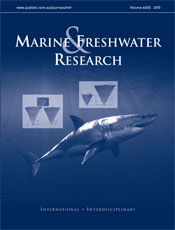Marine and Freshwater Research
Volume 66
Number 5 2015
Accurate age estimates are essential for the sustainable management and conservation of all fish populations, including sharks. In this study, we use vertebral band counts coupled with bomb carbon validation to estimate the age and growth of white sharks in the western North Atlantic. Our findings indicate that this species grows significantly slower and lives considerably longer than previously thought.
Fishery-independent surveys were undertaken to investigate shark communities along ~400 km of the tropical eastern coast of Australia. Multivariate analyses identified significant spatial heterogeneity in immature-shark communities. Results demonstrated that data on nursery function from restricted areas may not accurately portray patterns occurring over broader geographic scales, and this diversity may provide population-level benefits for sharks.
Inferring fish movements between marine and freshwater from otolith chemistry generally assumes that the strontium : calcium ratio is positively related to salinity and the barium : calcium ratio negatively related. This study of jungle perch (Kuhlia rupestris) provides an example where both otolith strontium : calcium and barium : calcium increased upon transition from marine to freshwater. While this atypical result driven by variation in ambient calcium challenges the above assumption, variation in the otolith element : calcium ratios remained consistent with variation in the ambient ratios.
Managing any inland fishery requires reliable age data and accurate estimates of growth rate. We used otolith-derived age estimates to compare patterns of age and growth for Clarias gariepinus from the Lower Okavango Delta in northern Botswana to those from the Upper Delta and found that two distinct populations of C. gariepinus may exist between the two regions. The fairly short life span and high variability in growth of C. gariepinus in the Lower Okavango Delta are important indicators that it is imperative to maintain natural habitat and flow regime for sustainable management of fishery resources in flood pulsed ecosystems.
Underwater video was used to observe the fish assemblage surrounding an offshore artificial reef, in Sydney, Australia. We found up to 10 times more fish on the reef itself than at 30, 100 and 500 m from the reef. This suggests that artificial reefs are very effective at increasing fish abundance, but generally act on a localised scale (<30 m).
In minimally disturbed river systems, identifying the influence of physical habitat on biological structure is important if the effects of alterations to physical habitat are to be understood. This study determined whether four channel types in an existing process-based geomorphic typology had distinct physical habitat and macroinvertebrate community composition. The findings reveal geomorphic typing of rivers can provide an initial assessment of ecological status and physical habitat conditions.
We tested how loss of litter diversity and time after loss of diversity affect leaf breakdown by invertebrate shredders. Changes in plant litter diversity affected shredders activity (leaf consumption and FPOM production), and the quality of food resources (FPOM and shredders) to higher trophic levels in streams; such effects are likely to become stronger with time after loss of diversity.
We used mtDNA sequences to study the population genetic structure in the stream dwelling caddisfly Rhyacophila minor. We detected significant genetic subdivision across a spatial scale of only 45 km, and a phylogeographic break that corresponded with the characteristics of bedrock and surficial geology. This study demonstrates the roles that limited gene flow and genetic drift have in driving population differentiation at small spatial scales.
Changes in trait proportions were used to assess the effects of an uncommon drought event in diatom and macroinvertebrate communities in Atlantic-temperate perennial streams. The trait proportions of these temperate communities were also compared with those from temporary Mediterranean streams. This study suggests that the effects of drying were long-lasting for macroinvertebrates. However, only the diatom shifted towards proportions occurring in Mediterranean streams.




